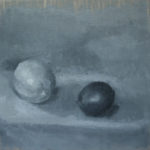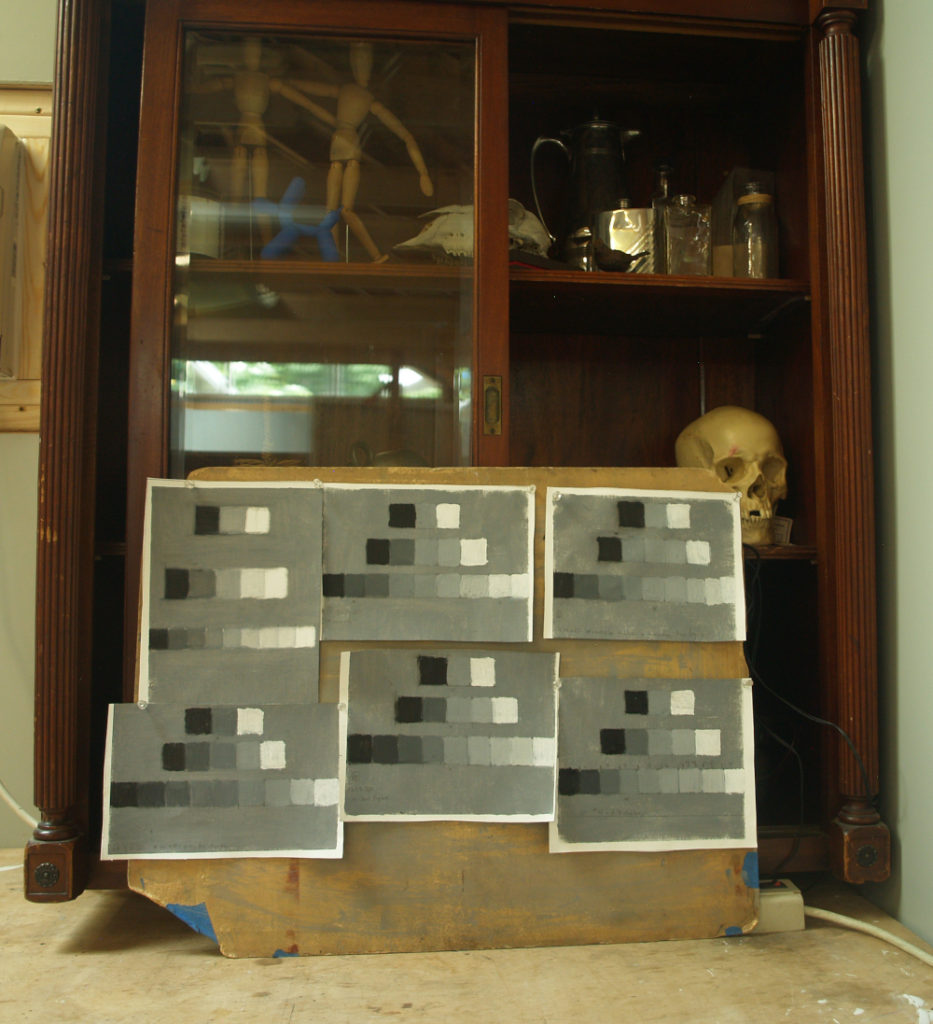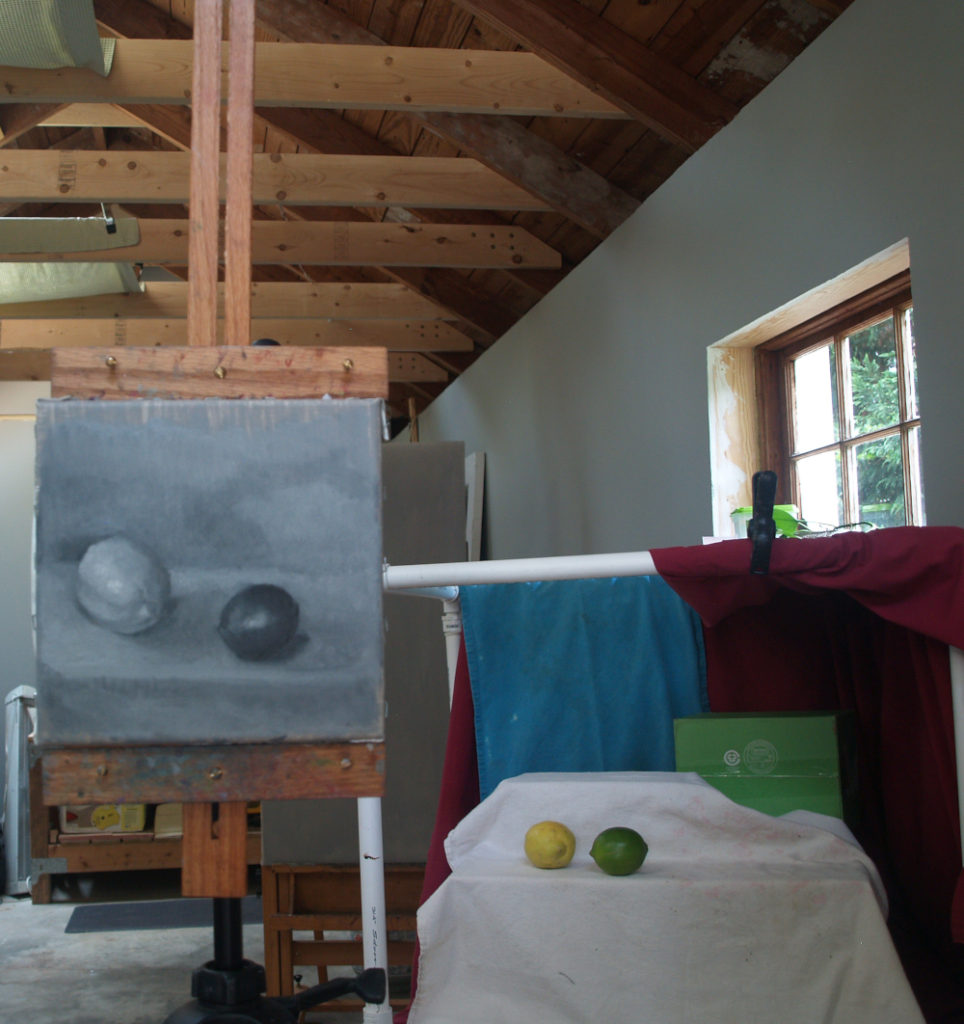Lemon Lime Value Study

Greetings dear reader! Here’s an 8×8 inch oil on linen Lemon Lime Value Study for you. To me, lemon lime time means summer time. You? I love the taste of a slice of lemon in water. And, there’s nothing more delicious than a gin and tonic with a slice of lime. Furthermore, when you savor the tangy flavor of each, it feels cool and summery, too.
Welcome
Welcome to summer and this blog where I share a painting each week as a part of this series. I hope these weekly paintings and this blog post lift you up, offer you some information and a bit of inspiration. If you want to make sure you receive these posts each week, please feel free to subscribe here and thank you. Now let’s cover the technical aspects of this painting so you can see what I hoped to accomplish. And, I know you may be wondering…
Where’s the Color
So, guess what? You’re right! I did this entire painting using two colors: Ivory black and Titanium White. Wondering why? Well, I have been out of school for two years now. And, I wanted to focus on a fundamental skill and paint a value study this week. Why? Perhaps if I share the exercise, you will see!
Goal of Realistic Painting
One of the primary goals of realistic painting is to show the impact of light on a three dimensional form. This form can be a figure or a still life object or even a landscape. To achieve this goal, the painter must make the object he/she is painting look three dimensional on a canvas (a two dimensional surface).
What is an effective way to show a three dimensional form on a two dimensional surface? Good question! The answer? Values! Am I speaking of personal values? No, I am speaking of a value scale that you, dear reader, use to communicate form.
What is a Value Scale
A value scale is a system of showing dark and light tones. This system creates a reference for you and I to problem solve and see if a drawing or painting appears to be realistic or not. For instance, you can have a 3 tone value scale that has black at one end, grey in the middle and white on the opposite end.
There are two more value scales you can use. Each expands on the scale above. The 5 tone value scale includes the three values I describe above. And, adds a value in between the black and middle grey. And, the 5 tone value scale also has another value between the middle grey and the white.
Lastly, is the 9 tone value scale. Rather than describe the name of each tone in this scale. I will show you an image of it and the other two scales. But first, I’ll share an exercise with you.
Value Exercise
If you are hoping to improve the success of your realistic drawings or paintings, try this simple but significant exercise. You can do this with graphite pencil on white paper first if you’d like.
For our purposes, I will share the painting exercise and the steps involved. But first, here’s a photograph of the exercise.

So the first thing I did was tone some canvas to a middle grey. Then I used a pencil, to measure out and mark a three tone, five tone and nine tone value scale. The next thing I did? Fill in the black box on the left and the white box on the right. Easy Peasey, right?
Then I used a palette knife to mix a middle grey that is ever so slightly lighter than the tone of the canvas. I painted that value in the middle of all three value scales. Voila! Congratulations. You have finished your first three tone value scale, right?
Next I find that I need to help my eye distinguish light values more than dark values. So, what is the next step? I mixed up a light value for the 5 tone scale and for the nine tone scale. And, I continued the process for the lighter ‘side’ of the value scale until I had no more empty boxes.
Then I mixed a darker tone for the values to the left of the middle value for the 5 and 9 tone scales. Please know that you will make some mistakes along the way. That’s OK! Forgive yourself! Learn!
Best way to learn
What is the best way to learn this value scale and apply it? First, plan to do this exercise multiple times. If you look at the photograph above you can see that I have done this exercise 6 times. What does that mean? It means I did this six days in a row. And, I will probably continue this for several more days.
I recommend that you leave your daily scales, as is. Study them. Think about what looks off. For instance, if you look at the first value scales I did in the upper left hand corner, you can see a problem. What? I made the middle value too light. This, in turn, meant all the remaining light values were too light. But, hey, that’s OK! I was mindful of this on day two. The results of the second day are directly below day 1. Day 3 and 4 are in the middle column. Day 5 and 6 are in the column on the right.
Now it’s time for a Value Study
Once you have completed a value scale, it’s time to do a value study. So, set up a simple still life object. Make sure you have an object that casts a shadow, has part of the object in light and part of the object in shadow. Here’s a photograph of my studio set up so you can get an idea of what I mean. Most of the light is coming in from the east facing windows in the upper left of the image. So, the lemon and lime are casting shadows to the right. Confession, you super smarty and observant readers may notice something about my set up. Did you guess?
You’re right…that is, my little lemon and lime have no obvious form shadow. And, I intentionally set that problem up for myself. Why? Because I need to use the same skills to show the form of these two objects with or without their form shadow.

If you are an overachiever, consider doing a value study each day after you complete your value scales. I guarantee you will see a significant improvement in your realistic paintings if you do this exercise every day for at least a week.
Something is missing
You’ll notice I didn’t mention any news nor did I share information about an accomplished living (or dead!) artist in this week’s post. Ah well! There is only so much we can cover in a day or in a blog post. Don’t you agree?
And, you can be sure that yours truly is keeping an eye out on the news, black lives matter, contemporary artists, and art history. But, for today, I hope you enjoy this value study of a lemon and lime. Are there exercises that you like to do in your world that help you stretch and strive towards your goals? If so, please share in the comments below and thank you so much for reading today!

6 Comments
Beth Dyer Clary
July 17, 2020Learned a lot reading this, Julie. Lots of factors I’d never considered come into play with realistic painting. You’d explained value studies before but not in quite this way which helped me understand more clearly. Lots of time and things you’re thinking about all at once! Wow.
Julie Holmes
July 21, 2020Hi Beth! Thanks for reading this kinda nerdy art ‘how to’ blog! It does sometimes feel as if my brain is juggling lots of process and ideas at once. Definitely keeps me out of trouble – ha!!! Thanks so much for reading and commenting!!!
Alexandra
July 18, 2020Another thought-provoking and enlightening post, Julie! You show how many things an artist has to keep in mind while painting. I feel like it’s a real juggling act sometimes. Picking each element apart – in this case value – as you describe is so helpful to understanding how to convincingly portray one’s vision. I also really enjoyed studying the value scales you did on different days and noticing the subtle changes where you get closer and closer to a more equal scale. Great exercise and wonderful job!
Julie Holmes
July 21, 2020Hi Alexandra, Thank you for reading! As an artist who paints realistically, and beautifully I might add, you know the challenges of refining work! As I do these exercises I’m reminded of the expression “one step forward two steps backward.” Some of the value studies, like paintings, don’t always show a linear, upward pointing improvement. Ah well…all part of the journey, right? Thanks so much again for reading, looking and commenting!!!
Alexandra
July 23, 2020A journey, indeed! Well said. Thank you also for your kind words about my work.
Julie Holmes
July 24, 2020You bet, Alexandra! Take care xoxo